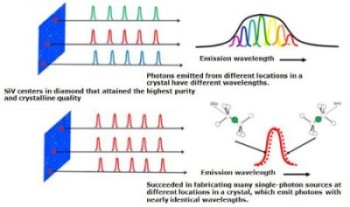Sep 10 2014
The research group led by Junichi Isoya, professor emeritus, University of Tsukuba, and Tokuyuki Teraji, principal researcher, Optical and Electronic Materials Unit, NIMS, succeeded for the first time in the world in fabricating single-photon sources of SiV centers which are one of the color centers in diamond during the growth of thin film diamond having high purity and crystalline quality by introducing them at extremely low concentrations. The results of this research have been published in Nature Communications 5, Article number:4739, doi:10.1038/ncomms5739.
 Figure 4 in the press release material. The research group resolved the challenging issue attributed to solid crystals, namely widely spread emission wavelengths, and succeeded in fabricating many single-photon sources that emit photons with nearly identical emission wavelengths.
Figure 4 in the press release material. The research group resolved the challenging issue attributed to solid crystals, namely widely spread emission wavelengths, and succeeded in fabricating many single-photon sources that emit photons with nearly identical emission wavelengths.
Abstract
The research group led by Junichi Isoya, professor emeritus, University of Tsukuba (also a former principal researcher, Research Center for Knowledge Communities, University of Tsukuba), and Tokuyuki Teraji, principal researcher, Optical and Electronic Materials Unit, NIMS, succeeded for the first time in the world in fabricating single-photon sources of SiV (silicon vacancy) centers which are one of the color centers in diamond during the growth of thin film diamond having high purity and crystalline quality by introducing them at extremely low concentrations.
By using this advanced technology to grow diamond thin film, the research group succeeded in fabricating many bright and stable single-photon sources at different locations in a crystal. Furthermore, the group obtained nearly identical emission spectra, with an spectral overlap of 91 %, between two photons emitted from two single-photon sources that were fabricated at different locations in a crystal. These results are promising as a key step toward the realization of using single-photon sources in solid matter applied to such fields as quantum optics, quantum computing and quantum information networks that involve quantum interference.
This research was jointly carried out with Fedor Jelezko, a professor at the University of Ulm in Germany, as part of Japan-Germany joint research (in nanoelectronics) on “quantum computing in isotopically engineered diamond,” supported by the JST Strategic International Collaborative Research Program.
The results of this research had been published in the 8-27-2014 issue of Nature Communications (Nature Communications 5, Article number:4739, doi:10.1038/ncomms5739)